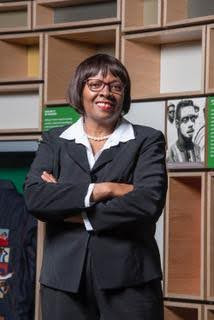By: Marc Rapport, WeGOJA Board
May 14, 2024
Elaine Nichols’ path to becoming a nationally known museum curator took an unexpected turn thanks to a group of Palmetto State ninth-graders with an unexpected curiosity about death and mourning customs.
As a volunteer graduate student reviewing label content for the South Carolina State Museum, Nichols was initially hesitant to accept an invitation to curate an exhibition on African American funeral traditions, assuming it wouldn’t pique public interest. However, after engaging with a class of 60 students, she realized their unfiltered enthusiasm for what she thought might be a taboo topic for them prompted her to embrace the opportunity wholeheartedly.
The resulting exhibition, “The Last Miles of the Way: African American Funeral and Mourning Customs in South Carolina, 1890-Present,” garnered international attention, with requests for its catalog pouring in from countries like Germany, Africa, Switzerland, and Australia. TIME magazine even dedicated a full-color page spread and a page and a half to covering the groundbreaking showcase, which featured stories from nearly 100 Black South Carolinians about traditions like placing quilts on graves to keep the spirit warm. This unexpected success paved the way for Nichols’ full-time curatorial role at the museum.
Preserving Stories, Celebrating Heritage
After completing her degree in public archaeology at the University of South Carolina, Nichols became a full-time curator at the State Museum and then in 2009 became the supervisory curator of culture at the Smithsonian’s National Museum of African American History and Culture (NMAAHC) in Washington, D.C.
Her responsibilities include curating costumes, textiles, and decorative arts, including the Black Fashion Museum collection and the Ebony Fashion Fair collection. And her passion for telling stories that teach people about history and culture through artifacts endures.
One of her proudest moments was securing the outfit worn by Shannon Faulkner when she was admitted to The Citadel as its first female cadet, a groundbreaking event that opened doors for women at the military college, despite Faulkner’s eventual departure due to the traumatic experience.
Nichols went to great lengths, even visiting Faulkner’s parents’ home in Powdersville, to obtain the camel-colored coat, cream-colored shoes, and shirt, which were displayed behind plexiglass at the South Carolina State Museum. “In this case it was a white person who pioneered and opened doors for other women, for other people,” Nichols reflects. “She suffered for it, but she did it anyway.”
Honoring Unsung Heroes
In addition to her curatorial duties, Nichols served as the founding project curator for the Civil Rights History Project (CRHP), a collaboration between NMAAHC and the Library of Congress that collected oral histories from more than 130 grassroots activists, supporters, and national leaders involved in the civil rights movement during the 1950s and 1960s.
One figure whose story particularly resonates with Nichols is tennis legend Althea Gibson, the first Black player to compete at the U.S. National Championships (now the U.S. Open) and the first to win both that tournament and Wimbledon.
Despite her groundbreaking achievements, Gibson was never honored by her home state of South Carolina. Nichols said she never met Gibson in person but that the Clarendon County native shared her sadness about that with the curator in a phone call made in an effort to bring her to the state for an exhibition.
“It was heartbreaking,” Nichols recalls. “She started out with paddleball, gravitated to tennis. Unfortunately, South Carolina never recognized Althea Gibson and her contributions to tennis. No Order of the Palmetto, no parade, nothing. That was heartbreaking for her.”
Forging Connections, Inspiring Future Generations
Nichols is a Charlotte native who also earned a master’s degree in social work from Case Western Reserve University in Ohio, where she learned how to work with diverse organizations and individuals to help improve communities.
That experience and her schooling and work in Columbia confirmed to her the ongoing importance of collaboration among museums, preservation efforts, and multiple other stakeholders to safeguard our shared heritage.
“We work with other entities involved in preservation because so many national treasures are at risk of getting lost,” she says, citing instances of cultural insensitivity and apathy that resulted in destruction of historic sites and artifacts.
To address and help prevent this, Nichols stresses the need to educate and inspire younger generations about the value of cultural heritage. She encourages individuals to explore their interests, research their family history, and pass down stories and artifacts to future generations, ensuring that diverse voices and perspectives are elevated and celebrated for years to come.
“You have to tell someone why it’s valuable, why it’s important to you,” she says. “Those objects and those stories help us understand who we are and who we will become. They help safeguard our access to different voices and perspectives by elevating those hidden stories.”
Through her groundbreaking exhibitions, research, and advocacy, Elaine has become a trailblazer in the museum world, using her platform to amplify underrepresented narratives and inspire a deeper appreciation for the richness of African American history and culture through dress and other personal artifacts that help tell collective stories that otherwise would be lost.

